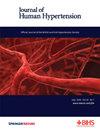健康年轻人的运动收缩压不受一天中时间的影响。
IF 2.7
4区 医学
Q2 PERIPHERAL VASCULAR DISEASE
引用次数: 0
摘要
运动测试期间的血压(BP)评估能够识别出运动血压过高(EEBP)。血压具有昼夜节律;因此,运动血压可能在一天中发生变化,从而使 EEBP 的识别变得复杂。本研究的目的是确定一天中的时间对健康年轻人运动血压的影响。31 名参与者(48% 为女性;23(4)岁)分别在上午(M)、下午(A)和晚上(E)完成了改良布鲁斯跑步机方案。测定了次极限(第 4 阶段)和峰值(最高值)收缩压(SBP),并计算了ΔSBP(峰值 SBP-运动前 SBP)。重复测量检验用于比较 SBP 数据。EEBP 的定义是亚极限 SBP ≥ 170 mmHg。使用晨间-活力问卷(MEQ)评估时型,并使用皮尔逊相关性来确定所有测试中 MEQ 分数与 ΔSBP 之间的关系。显著性设定为 P本文章由计算机程序翻译,如有差异,请以英文原文为准。


Exercise systolic blood pressures are unaffected by time of day in healthy young adults
Blood pressure (BP) assessment during exercise testing has the capacity to identify exaggerated exercise BP (EEBP). BP has a circadian rhythm; therefore, exercise BPs may change throughout the day complicating EEBP identification. The purpose of this study was to determine the effect of time of day on exercise BP in healthy young adults. Thirty-one participants [48% female; 23(4) years] completed a modified Bruce treadmill protocol in the morning (M), afternoon (A), and evening (E). Submaximal (stage 4) and peak (highest value) systolic BP (SBP) were determined and ΔSBP was calculated (peak SBP-pre-exercise SBP). Repeated-measures tests were used to compare SBP data. EEBP was defined as a submaximal SBP ≥ 170 mmHg. Chronotype was assessed using the Morning-Eveningness Questionnaire (MEQ) and Pearson correlations were used to determine the relationship between MEQ score and ΔSBP during all tests. Significance was set at P < 0.05. Submaximal SBP (M:159(25); A:156(16); E:162(24) mmHg; P = 0.295), peak SBP (M:177(32); A:184(25); E:185(26) mmHg; P = 0.087) and ΔSBP (M:62(29); A:67(23); 65(20) mmHg; P = 0.546) were similar across time points. Eight participants had an EEBP on at least two tests. MEQ scores were correlated with ΔSBP during the A test (r = 0.357, P = 0.049) and E test (r = 0.363, P = 0.045). In conclusion, time of day had no effect on SBP responses to exercise, but our correlational analysis suggests changes in SBP may differ between chronotypes depending on the time of day of exercise. Given the clinical value of EEBP, it is notable that 26% of our healthy young sample had EEBP.
求助全文
通过发布文献求助,成功后即可免费获取论文全文。
去求助
来源期刊

Journal of Human Hypertension
医学-外周血管病
CiteScore
5.20
自引率
3.70%
发文量
126
审稿时长
6-12 weeks
期刊介绍:
Journal of Human Hypertension is published monthly and is of interest to health care professionals who deal with hypertension (specialists, internists, primary care physicians) and public health workers. We believe that our patients benefit from robust scientific data that are based on well conducted clinical trials. We also believe that basic sciences are the foundations on which we build our knowledge of clinical conditions and their management. Towards this end, although we are primarily a clinical based journal, we also welcome suitable basic sciences studies that promote our understanding of human hypertension.
The journal aims to perform the dual role of increasing knowledge in the field of high blood pressure as well as improving the standard of care of patients. The editors will consider for publication all suitable papers dealing directly or indirectly with clinical aspects of hypertension, including but not limited to epidemiology, pathophysiology, therapeutics and basic sciences involving human subjects or tissues. We also consider papers from all specialties such as ophthalmology, cardiology, nephrology, obstetrics and stroke medicine that deal with the various aspects of hypertension and its complications.
 求助内容:
求助内容: 应助结果提醒方式:
应助结果提醒方式:


